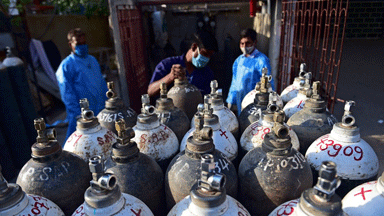GASP: In the final stages of Covid-19 infection patients require oxygen as their lungs are infected. Oxygen has to be pumped up the nostrils at high pressure. The BJP is being accused of playing politics and depriving worst hit states like Maharashtra of vaccinations and oxygen
By Arjun Srinivas,
With the number of covid-19 cases shooting up both nationally and in Goa there is a severe shortage of isolation beds, ICU beds, oxygen and Remdesivir. …
If the current coronavirus trajectory sustains, India’s worst-affected states would face massive shortages in isolation beds, ICU beds, and ventilators in the second half of May
As India enters the final phase of lockdown 2.0, the preparedness of its healthcare infrastructure to combat covid-19 will come into increasing focus. Five weeks of lockdown have managed to slow the rate of growth of infection, with cases doubling in roughly 10 days. But the battle against the virus is far from over. As the lockdown is relaxed in a phased manner, and with expatriate Indians set to return, there could be a surge in cases.
What is the readiness of healthcare infrastructure of individual states? If infections continue to rise at the same rate in May as they have done so far in April, India could be facing a deficit in isolation beds by the end of May, and in intensive care unit (ICU) beds and ventilators by the first week of June, a Mint analysis suggests.
The infrastructure stress will be especially acute in eight high-burden states, led by Gujarat, Maharashtra and Delhi. In April, cases in all these eight states grew at a compounded daily rate of above 10%—or, a doubling in about seven days or less. At the other end are states whose case growth is slower and which have greater reserves of covid-critical infrastructure relative to their case count.
Healthcare capacity is also a moving target. Till the night of 27 April, the policy directive was to mandatorily isolate everyone who tested corona-positive in a standalone facility. This facility could be an entire hospital or a separate block where other patients are not allowed. This necessitated the establishment of isolation wards.
However, considering the scenario that these facilities might be overwhelmed, the Union health ministry issued a directive on 27 April allowing “very mild” and pre-symptomatic patients to isolate at home, provided they fulfil an eight-point eligibility criteria. The key requirement was space for separate quarantining of family members, a challenge for most Indian households.
For this analysis, we have considered that all corona-positive patients need an isolation bed. Further, we have considered state-wise counts of isolation beds from a 5 April health ministry document that outlined capacity of various covid-critical infrastructure.
As of 4 April, India had 152,403 isolation beds. Rajasthan had the most (20,835), followed by Tamil Nadu (19,860) and Kerala (13,028). Maharashtra, which had the maximum number of coronavirus cases (8,100) as of 26 April, had 11,861 isolation beds. The ministry document projected a compounded daily growth rate (CDGR) of 2% in isolation beds. We have taken a 4% CDGR to factor in intensification of efforts.
Finally, to account for further augmentation by the private sector, a multiplier of 0.5 of the share of the private sector in hospital beds in the state is applied to the count of isolation beds available.
To explain, Maharashtra has 78% hospitalization in private facilities, according to a 2017-18 National Sample Survey Office (NSSO) survey. So, we assumed an increase in the number of isolation beds in the state (11,861) by 39%, or a total of 16,487 on 4 April (with the private sector providing the additional beds).
For ICU beds and ventilators, we have considered a 2% CDGR since these facilities are more expensive and time-consuming to provide. In line with projections from various global studies, we have assumed that 5% of cases require ICU care and 3% of cases would be on the ventilator. Lastly, we have projected cases in each state increasing at the CDGR recorded by it between 1 April and 26 April. This ranges from around 14% in West Bengal to 1.5% in Goa. At their respective rates, Maharashtra and Gujarat will be the worst-affected states, with over 700,000 and 530,000 cases, respectively, by 31 May.
This would put immense strain on the healthcare infrastructure, with both states running a deficit in isolation beds by 17 May. Going by ministry numbers, Delhi is already running a deficit in isolation beds. By 31 May, India will fall short of isolation beds at an aggregate level, with West Bengal, Madhya Pradesh, Jharkhand and Uttar Pradesh joining them.
In terms of ICU beds and ventilators, India will show a shortage at an aggregate level by 7 June, with Delhi, Gujarat and Maharashtra again the worst-affected.
In spite of the apparent slowing down of growth in coronavirus cases, there is no scope for complacency.
Unless the trajectory slows down further, India’s medical capacity will be overwhelmed soon. The announcement that low-risk patients can self-isolate at home will provide some respite to the authorities, but this might enhance the risk of transmission in the community. Governments at the state and Centre must double up efforts to contain case growth and augment health infrastructure.
Coutersy:www.livemint.com
